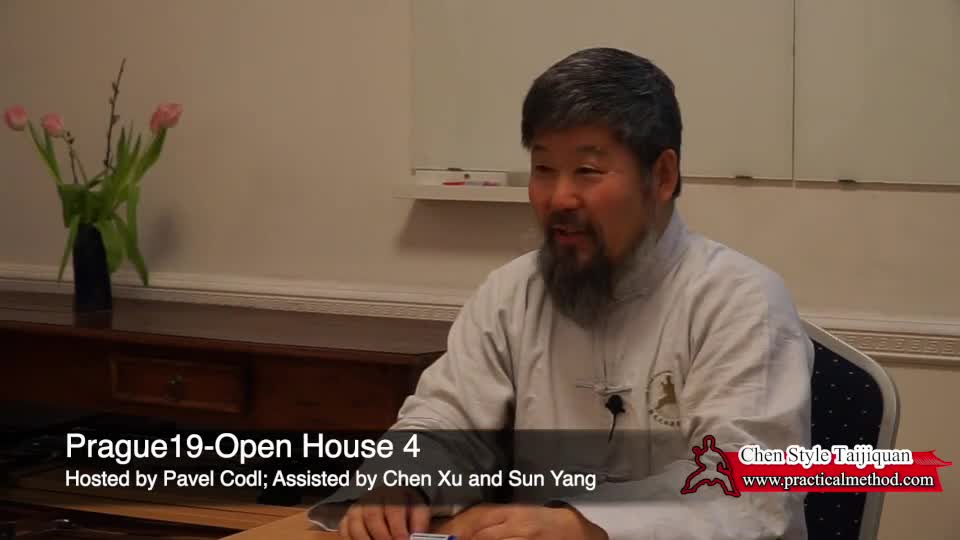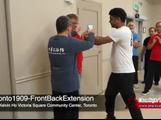In this video, Master Chen Zhonghua explains the concept of energy going into the Dantian and coming out of Dantian. This is a governing concept for the control and movement of energy in the body. Presenter: Chen Zhonghua Length: 7 min. In: English Year: 2020 Difficulty:3/5 At:Edmonton Chen Zhonghua Taiji Academy 加拿大埃德蒙顿陈中华太极馆 Read more
Knowledge : Principle-Concept
Chen Zhonghua teaches how to kick in Practical Method. Presenter: Chen Zhonghua Length: 2 min. In: English Year: 2020 Difficulty:1/5 At:Edmonton Chen Zhonghua Taiji Academy
Chen Zhonghua teaches to details of the move after “Wild Horse Parts Its Mane”. This is requested by Spencer Jones of Chicago.
Presenter: Chen Zhonghua Length: 3 min. In: English Year: 2020 Difficulty:3/5 At:Edmonton Chen Zhonghua Taiji Academy
Chen Zhonghua teaches how to produce a rod or rods in the body. Presenter: Chen Zhonghua Length: 6 min. In: English Year: 2020 Difficulty:1/5 At:Edmonton Chen Zhonghua Taiji Academy

This is an Answer by Chen Zhonghua to Spencer Jones’ question on synchronization and de-synchronization.
Presenter: Chen Zhonghua Length: 3 min. In: English Year: 2020 Difficulty:4/5 At:Edmonton Chen Zhonghua Taiji Academy
***************
Spencer Jones:
In the past I’ve heard you talk about the top half and lower half being two different rhythms. I was aimlessly trying to incorporate that into this move. This explanation is very clear. Now i just have to watch your movements in slow motion a few hundred times. Thanks again.
Chen Zhonghua:
Best way is to look at how the car moves. Wheels rotate and the body of the car moves forward. We normally assume that the car body movement and wheel movement are the same, are synchronized or are directly related. They are not. They are very indirectly related! If they are directly related, the car jerks!
Spencer Jones:
That is helpful. Thanks. I’ll send you a video of my progress once I’ve worked on it some.
Chen Zhonghua:
Another aspect of this de-synchronization can be observed in an old bicycle. In the old no gear bicycle, you pedal to power the bicycle. You pedal hard and fast to make it move faster. But you have the choice of stop pedaling and let the bicycle coast on its own. This means that there is a clutching and de-clutching process involved. Without it, you will have to pedal all the time and when the bicycle is going fast downhill, you might break your legs because you can not follow the speed of the pedals rotation!
The clutching and de-clutching, in our taiji terms, the synchronization and de-synchronization, is the yin yang union and yin yang separation.
This video describes the type of moves in the Chen Style Taijiquan Practical Method under the concept of Sink the Waist to Press the Elbow. Taught by Chen Zhonghua and videotaped by Allan Belsheim.
Presenter: Chen Zhonghua Length: 9 min. In: English Year: 2020 Difficulty:1/5 At:Edmonton Chen Zhonghua Taiji Academy
Skype class will be held at http://skype.practicalmethod.ca for this video at 10 am ET on Saturday, July 25, 2020. If you would like to join, please leave a message below.
![]()
Master Chen Zhonghua always amazes me, whether it is at the next workshop (there is always something new and amazing) or looking back — such as in this video captured during a workshop in Ottawa ten years ago… an easy, seemingly simple, and clean bounce:
What do you see in the video?
John Upshaw: Everything is on a line. He added the right leg to the line…left arm to right leg…
Lou Sacharske: Watch his right shoulder, as he adds the right leg, there is zero deviation to telegraph the execution.
James Tam: I believe the rotation axis is the one joining Shifu’s left shoulder and front foot. And, the stick (effective energy pathway) is from his back foot to Steve’s upper back.

Master Chen Zhonghua’s Sept. 2019 Toronto Practical Method Workshop Videos.
Presenter: Chen Zhonghua Length: 10 min. In: English Year: 2019 Difficulty:3/5 At:Toronto

Chen Zhonghua’s Sept. 2019 Toronto Practical Method Seminar.
Presenter: Chen Zhonghua Length: 10 min. In: English Year: 2019 Difficulty:3/5 At:Toronto

Chen Zhonghua’s 2019 Prague Practical Method Workshop videos. Presenter: Chen Zhonghua Length: 10 min. In: English Year: 2019 Difficulty:1/5 At:Prague

Chen Zhonghua’s 2019 Prague Practical Method Workshop videos.Presenter: Chen Zhonghua Length: 10 min. In: English Year: 2019 Difficulty:1/5 At:Prague

Chen Zhonghua’s 2019 Prague Practical Method Workshop videos. Presenter: Chen Zhonghua Length: 10 min. In: English Year: 2019 Difficulty:1/5 At:Prague

Chen Zhonghua’s 2019 Prague Practical Method Workshop videos. Presenter: Chen Zhonghua Length: 10 min. In: English Year: 2019 Difficulty:1/5 At:Prague

Chen Zhonghua’s 2019 Prague Workshop videos. Presenter: Chen Zhonghua Length: 10 min. In: English Year: 2019 Difficulty:1/5 At:Prague

Master Chen Zhonghua’s Sept. 2019 Toronto Workshop on Practical Method.
Presenter: Chen Zhonghua Length: 10 min. In: English Year: 2019 Difficulty:3/5 At:Toronto
Recently, I understand more about the statement:
“Rotation is the result of linear movements.”
Our actions are like on the tangent of a circle. The non-moving dot is the centre of the circle. Every linear action is very small. The direction changes all the time. The sequence of such actions along with non-moving dot cause the rotation. The actions are continued on top of each other, and they have a relationship with the non-moving dot. In the form, it is like dragging the flesh around some non-moving rod or dot. It is almost like someone pushes the arm on one side for elbow in, and someone else pushes the other side of the arm for hand out. This is related to the stretch that Master Chen Zhonghua showed on the inside or outside of the forearm. Another example is that if someone touches me in the front, I don’t move the front, but I stretch the back over or around that non-moving front.
Read more
Who is a true disciple?
A true disciple is someone who follows the teacher based on the principles of the teachings. When the teacher evolves in his understanding, a true disciple will do the same. Even if the teacher and the true disciple don’t see each other for an extended period of time, their evolutions will still head in the same direction.
Principle: Separation of Yin and Yang
Concept: Indirect Power
Action: In with elbow no hand, out with hand no elbow.
These are three ways of describing taiji. They are one and the same.
Master Chen Zhonghua discussed the above during a Q&A session at the North American Practical Method Training Camp from Jul 29 to Aug 2, 2017.
A 4 videos series explaining the concept of using joint power to generate force.
Using joint power is different then muscle power because using joints keep the body in place. Muscle power often rely on momentum which can be manipulated by opponent.
In addition joint power is additive, so the more the body is open, the greater the output.
 “Centered Move 1” “Centered Move 1” |
 “Centered Move 2” “Centered Move 2” |
 “Centered Move 3” “Centered Move 3” |
 “Centered Move 4” “Centered Move 4” |

Keeping arm joints in 45 degree so it can open when opponent want to lock it.
Presenter: Chen Zhonghua Length: 3 min. In: English Year: 2014 Difficulty:1/5 At:Berlin
 At the workshop in Maple Ridge today, we worked on “Stretching”. It is important to remember that a concept must be understood at it core level. We train the basic core elements of the concept, not its derivatives, deviations, adaptations or variations of the concept. For example, the core elements of a “stretch” is a locked point and a moving point. A variation is two moving points. Read more
At the workshop in Maple Ridge today, we worked on “Stretching”. It is important to remember that a concept must be understood at it core level. We train the basic core elements of the concept, not its derivatives, deviations, adaptations or variations of the concept. For example, the core elements of a “stretch” is a locked point and a moving point. A variation is two moving points. Read more
Sometimes watching something in nature can be helpful in gaining understanding a type of movement. If you watch generally speaking you see ‘everything moving’ in a wavelike manner. But if you look more closely you will notice the movement is actually the result of a sequence of isolated actions connected by stretch. Every thing is NOT moving at the same time. There is an energy flow through the segments.
The purpose of training is to enhance the hardness of the body in every aspect. This is a quality issue. Read more
Movements are in the bones; rotations are in the joints. All Practical Method movements are straight movements. The system requires rotations. Rotations are achieved in two ways: Read more
The understanding of vertical movements (line) and horizontal movements (line) is vital. Chen Style Taijiquan Practical Method system requires that all movements must be along the vertical line, not the horizontal line. Read more
Suspended head is an important principle of the Chen Style Taijiquan Practical Method. The suspended head allows the vertical stretch of the body to take place. This creates two lines in the body: 1) head left foot vertical line. 2) head right foot vertical line. Read more
Every push in the Chen Style Taijiquan Practical Method system must be converted into a pull. This is a major concept. Read more
 I believe that what happens to a connected person’s body when being pushed can be understood by understanding how a trampoline works. Read more
I believe that what happens to a connected person’s body when being pushed can be understood by understanding how a trampoline works. Read more
Key words:
- 【硬而不僵】: Ying er bu jiang. Hard but not stiff. This is a concept in Chen Style Taijiquan Practical Method.
- 松而不懈: Song er bu xie. Soft but not collapsed. This is a commonly used taiji phrase and concept. Read more
 This “natural” is not your “natural”. The master said so right at the first meeting. His explanations later on were mainly based on how to separate “self” from the objects that we observe. The “nature” taiji talks about is about the real nature out there. It is the one outside of self. Not the one the observer feels, sees, or believes. The master used the analogy of chopsticks to illustrate the Read more
This “natural” is not your “natural”. The master said so right at the first meeting. His explanations later on were mainly based on how to separate “self” from the objects that we observe. The “nature” taiji talks about is about the real nature out there. It is the one outside of self. Not the one the observer feels, sees, or believes. The master used the analogy of chopsticks to illustrate the Read more
 The circle, simply put, is the basis of every move in the Taijiquan Practical Method system. Every action or movement in the form is actually a part or variation of either the negative or positive circle. Therefore, common sense would suggest that one must gain a deep understanding of the circle and its mechanics in order to have any kind of understanding of Taijiquan and its practical applications. Read more
The circle, simply put, is the basis of every move in the Taijiquan Practical Method system. Every action or movement in the form is actually a part or variation of either the negative or positive circle. Therefore, common sense would suggest that one must gain a deep understanding of the circle and its mechanics in order to have any kind of understanding of Taijiquan and its practical applications. Read more
 Quality and quantity are two issues that come up a lot during training and seem to be the cause of some debate amongst practitioners. Generally most people have strong opinions about these two ideals and normally have specific training habits which clearly show which catergory they fall into. Read more
Quality and quantity are two issues that come up a lot during training and seem to be the cause of some debate amongst practitioners. Generally most people have strong opinions about these two ideals and normally have specific training habits which clearly show which catergory they fall into. Read more
第一勢 金剛搗碓(1) 只一勢言太極蔭陽之理皆具 Read more





